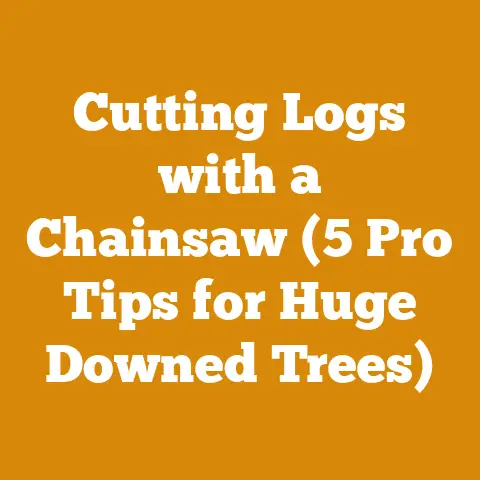How Much is Tree Service Insurance? (7 Climber-Pro Tips)
Alright, let’s dive into the often-murky world of tree service insurance costs. Here’s a pro tip right off the bat: Don’t just focus on the upfront premium. A low premium with high deductibles or inadequate coverage can be a recipe for disaster down the road. Instead, focus on finding the right balance of coverage and cost to protect your business from the unique risks of tree work. Now, let’s get into the details.
How Much is Tree Service Insurance? (7 Climber-Pro Tips)
The million-dollar question, or rather, the “how-many-thousands-of-dollars” question, when you’re running a tree service business. I’ve been in this business for years, and believe me, I’ve seen everything from shoestring operations to established companies. The cost of tree service insurance is a critical factor in your profitability and long-term sustainability. Let’s break it down, shall we?
A Personal Anecdote: Learning the Hard Way
Before we get into the nitty-gritty, let me share a quick story. Back when I was just starting out, I cut corners on insurance. It was a wake-up call. That’s when I learned that adequate insurance isn’t just a cost; it’s an investment in your peace of mind and the survival of your business.
Understanding the Variable Landscape of Tree Service Insurance Costs
The first thing you need to understand is that there’s no one-size-fits-all answer. The cost of your insurance will vary widely depending on a number of factors. Think of it like pricing firewood: the species, the dryness, the quantity – all impact the price. Similarly, several elements influence your tree service insurance premium.
The Key Cost Drivers
- Location, Location, Location: Where you operate has a HUGE impact. A tree service in bustling Southern California will pay dramatically more than one in rural Maine. This is due to factors like population density, the frequency of severe weather, and general litigation trends in the area.
- The Size of Your Crew: More employees mean more risk. Each additional climber, ground person, or equipment operator increases the potential for accidents and therefore, higher premiums.
- Your Payroll: Insurance companies use your payroll as a primary metric for assessing risk. A higher payroll typically translates to higher premiums.
- The Types of Services You Offer: Do you just prune small trees, or are you removing massive, hazardous trees near power lines? The more dangerous the work, the higher the risk, and the higher the premium.
- Your Equipment: The type and value of your equipment play a role. A fleet of well-maintained, modern chippers, bucket trucks, and chainsaws will often result in lower rates than an older, less reliable setup.
- Your Claims History: This is a big one. A history of accidents or claims will significantly increase your insurance costs. A clean record, on the other hand, can help you secure lower rates.
- Your Coverage Limits and Deductibles: Higher coverage limits (the maximum amount the insurance company will pay out) will result in higher premiums. Choosing higher deductibles (the amount you pay out of pocket before the insurance kicks in) can lower your premiums, but be careful not to set them so high that you can’t afford them in the event of a claim.
Breaking Down the Types of Insurance You Need
To understand the costs, you need to understand the different types of insurance that are essential for a tree service business. These are the core components that make up your overall insurance package.
1. General Liability Insurance
This is the foundation of your insurance coverage. It protects you from financial losses if someone is injured on your property or if you damage someone else’s property while performing tree work.
- What it covers: Bodily injury, property damage, and legal defense costs.
- Cost factors: Location, size of your business, claims history, and coverage limits.
- Typical cost range: $500 to $2,000+ per year for a small operation. Remember, this is a wide range, and your actual cost could be significantly higher or lower.
- Example: Let’s say you’re removing a tree, and a branch falls and damages a neighbor’s fence. General liability insurance would cover the cost of repairing or replacing the fence.
2. Workers’ Compensation Insurance
If you have employees, workers’ compensation insurance is usually legally required. It covers medical expenses and lost wages for employees who are injured on the job. Tree work is inherently dangerous, so this is a critical piece of the puzzle.
- What it covers: Medical bills, lost wages, and rehabilitation costs for injured employees.
- Cost factors: Payroll, the number of employees, the type of work you do (tree work is considered high-risk), and your state’s workers’ compensation rates.
- Typical cost range: This is usually calculated as a percentage of your payroll. In high-risk states, it can be 10% or more of your payroll. For example, if your payroll is $100,000 and your workers’ comp rate is 10%, you’d pay $10,000 per year.
- Example: An employee falls from a tree and breaks their leg. Workers’ compensation insurance would cover their medical bills and lost wages while they recover.
3. Commercial Auto Insurance
This covers your vehicles, including trucks, chippers, and bucket trucks, for accidents and other damages.
- What it covers: Vehicle damage, liability for injuries or damages caused by your vehicles, and uninsured/underinsured motorist coverage.
- Cost factors: The number of vehicles, the type of vehicles, the drivers’ driving records, and the coverage limits.
- Typical cost range: $1,000 to $5,000+ per vehicle per year. The cost of insuring a bucket truck will be significantly higher than insuring a pickup truck.
- Example: Your bucket truck is involved in an accident while driving to a job site. Commercial auto insurance would cover the cost of repairing the truck and any damages to other vehicles or property.
4. Inland Marine Insurance (Equipment Coverage)
This covers your tools and equipment, such as chainsaws, climbing gear, and chippers, for damage or theft.
- What it covers: Damage to or theft of your tools and equipment, whether they’re on your property, in transit, or at a job site.
- Cost factors: The value of your equipment, the type of equipment, and the coverage limits.
- Typical cost range: $200 to $1,000+ per year.
- Example: Your chainsaw is stolen from your truck while you’re working on a job. Inland marine insurance would cover the cost of replacing the chainsaw.
5. Umbrella Insurance
This provides an extra layer of liability coverage above your other policies. It’s like a safety net that kicks in when your other policies reach their limits.
- What it covers: Additional liability coverage for bodily injury, property damage, and lawsuits.
- Cost factors: The coverage amount, the underlying policy limits, and the risk profile of your business.
- Typical cost range: $500 to $2,000+ per year for $1 million in coverage.
- Example: You’re found liable for a significant amount of damages in a lawsuit, and your general liability policy isn’t enough to cover the full amount. Umbrella insurance would kick in to cover the remaining costs.
Optional but Recommended: Other Considerations
- Professional Liability (Errors and Omissions) Insurance: This protects you if you make a mistake in your professional advice or services. For example, if you misdiagnose a tree and recommend a treatment that damages it further, this insurance could cover the costs.
- Pollution Liability Insurance: This covers damages caused by pollution or contamination resulting from your tree work. For example, if you spill oil or chemicals on a job site, this insurance could cover the cleanup costs.
Diving Deeper: Cost Factors in Detail
Let’s go beyond the basics and examine the specific elements that influence your tree service insurance costs. Understanding these factors will empower you to make informed decisions and potentially lower your premiums.
Location, Revisited: A Geographic Perspective
As I mentioned earlier, where you operate is a significant cost driver. Here’s why:
- Urban vs. Rural: Urban areas tend to have higher insurance costs due to increased population density, more traffic, and a greater risk of property damage.
- State Regulations: Each state has its own insurance regulations and requirements, which can impact premiums. For example, some states have stricter workers’ compensation laws than others.
- Weather Patterns: Areas prone to severe weather, such as hurricanes, tornadoes, or ice storms, will typically have higher insurance costs due to the increased risk of tree damage and accidents.
- Litigation Climate: Some areas are more prone to lawsuits than others. If you operate in an area with a high rate of litigation, your insurance costs will likely be higher.
Data Point: According to a 2023 report by the Insurance Information Institute, the average cost of a general liability claim in the United States is approximately $30,000. This figure can vary significantly depending on the location and the severity of the claim.
The Crew Factor: Payroll and Employee Classifications
Your payroll and the number of employees you have are key factors in determining your insurance costs, particularly for workers’ compensation.
- Employee Classifications: Insurance companies classify employees based on the type of work they do. Tree climbers, for example, are classified as high-risk and will have a higher workers’ compensation rate than ground personnel.
- Payroll Reporting: Accurate payroll reporting is crucial. Underreporting your payroll can lead to serious consequences, including fines and policy cancellation.
- Safety Training: Investing in safety training for your employees can help reduce accidents and lower your workers’ compensation costs over time.
- Experience Modification Rate (EMR): Your EMR is a factor that reflects your company’s past claims experience compared to other companies in your industry. A lower EMR means lower workers’ compensation costs, while a higher EMR means higher costs.
Data Point: The National Council on Compensation Insurance (NCCI) sets the rates for workers’ compensation insurance in many states. These rates vary depending on the industry and the employee classification.
Service Spectrum: Risk Assessment Based on Job Complexity
The types of services you offer directly impact your insurance costs. The more dangerous the work, the higher the risk, and the higher the premium.
- Tree Removal vs. Pruning: Tree removal is generally considered more dangerous than pruning and will result in higher insurance costs.
- Hazardous Tree Work: Removing trees near power lines or buildings is considered high-risk and will significantly increase your insurance costs.
- Stump Grinding: While seemingly less dangerous than climbing, stump grinding presents its own risks and can affect your premiums.
- Emergency Services: Offering emergency tree services, such as storm damage cleanup, can also increase your insurance costs due to the increased risk of accidents.
Example: A tree service that specializes in removing large, hazardous trees near power lines will pay significantly more for insurance than a service that only prunes small trees in residential areas.
Equipment Equation: Value and Maintenance
The type and value of your equipment, as well as how well you maintain it, can influence your insurance costs.
- Equipment Value: The higher the value of your equipment, the more it will cost to insure.
- Equipment Maintenance: Regularly maintaining your equipment can help prevent accidents and lower your insurance costs.
- Equipment Safety Features: Investing in equipment with advanced safety features, such as automatic shut-off switches and anti-kickback devices, can also help lower your insurance costs.
- Storage and Security: How you store and secure your equipment can also impact your insurance costs. Secure storage can help prevent theft and vandalism, which can lead to claims.
Data Point: According to a study by the Equipment Leasing and Finance Association, proper equipment maintenance can reduce downtime by as much as 20% and extend the life of your equipment by several years.
Claims Chronicle: The Impact of Past Incidents
Your claims history is a major factor in determining your insurance costs. A history of accidents or claims will significantly increase your premiums.
- Frequency and Severity: The more frequent and severe your claims, the higher your insurance costs will be.
- Loss Control: Implementing a strong loss control program can help prevent accidents and lower your insurance costs over time. This includes things like safety training, regular equipment inspections, and a written safety plan.
- Claims Management: How you handle claims can also impact your insurance costs. Promptly reporting claims and cooperating with the insurance company can help minimize the costs associated with the claim.
- Clean Record Benefits: A clean claims record can help you secure lower insurance rates and may even qualify you for discounts.
Example: A tree service that has had several workers’ compensation claims in the past will pay significantly more for insurance than a service with a clean claims record.
Unveiling the Pricing Structure: How Insurance Companies Calculate Premiums
Understanding how insurance companies calculate premiums can help you make informed decisions and potentially lower your costs.
The Actuarial Angle: Risk Assessment and Statistical Modeling
Insurance companies use actuaries to assess risk and calculate premiums. Actuaries analyze historical data, statistical models, and other factors to determine the likelihood of future claims.
- Risk Factors: Actuaries consider a wide range of risk factors, including location, payroll, employee classifications, the types of services you offer, your equipment, your claims history, and your safety practices.
- Statistical Models: Actuaries use statistical models to predict the likelihood of future claims based on these risk factors.
- Premium Calculation: The premium is calculated based on the assessed risk and the desired profit margin for the insurance company.
The Underwriting Process: Evaluating Your Business Profile
Underwriters are responsible for evaluating your business profile and determining whether to offer you insurance coverage.
- Application Review: Underwriters review your insurance application and supporting documents to assess your business profile.
- Risk Assessment: Underwriters assess the risk associated with your business based on the information provided in your application.
- Premium Determination: Underwriters determine the premium based on the assessed risk and the insurance company’s pricing guidelines.
- Policy Terms and Conditions: Underwriters also determine the terms and conditions of your insurance policy, including the coverage limits, deductibles, and exclusions.
The Formula Revealed: A Simplified Explanation
While the actual formulas used by insurance companies are complex and proprietary, here’s a simplified explanation of how premiums are calculated:
Premium = Base Rate x Risk Factors x Coverage Limits x Profit Margin
- Base Rate: This is the starting point for the premium and is based on the average risk for your industry and location.
- Risk Factors: These are the factors that increase or decrease your risk, such as your payroll, employee classifications, claims history, and safety practices.
- Coverage Limits: This is the maximum amount the insurance company will pay out in the event of a claim.
- Profit Margin: This is the insurance company’s desired profit margin.
Climber-Pro Tips: Strategies for Minimizing Insurance Costs
Now for the good stuff: practical tips and strategies for minimizing your tree service insurance costs without compromising your coverage.
1. Shop Around: Compare Quotes from Multiple Insurers
Don’t settle for the first quote you receive. Get quotes from multiple insurance companies to compare prices and coverage options.
- Independent Agents: Work with an independent insurance agent who can shop around for you and find the best rates.
- Online Quotes: Get online quotes from multiple insurers, but be sure to compare the coverage details carefully.
- Coverage Comparison: Don’t just focus on the price. Compare the coverage limits, deductibles, and exclusions to make sure you’re getting the right coverage for your needs.
2. Enhance Safety Protocols: A Proactive Approach
A strong safety program can help prevent accidents and lower your insurance costs over time.
- Safety Training: Provide regular safety training to your employees on topics such as tree climbing techniques, chainsaw safety, and electrical hazards.
- Equipment Inspections: Conduct regular inspections of your equipment to identify and address any potential safety hazards.
- Written Safety Plan: Develop a written safety plan that outlines your company’s safety policies and procedures.
- Safety Incentives: Offer incentives to employees for following safety procedures and reporting potential hazards.
3. Prune Your Risks: Selective Service Offerings
Consider limiting the types of services you offer to reduce your risk profile.
- Focus on Pruning: If you’re just starting out, consider focusing on pruning rather than tree removal, as pruning is generally considered less dangerous.
- Avoid Hazardous Work: Avoid taking on jobs that are particularly hazardous, such as removing trees near power lines or buildings, unless you have the necessary expertise and equipment.
- Subcontracting: Consider subcontracting out certain types of work, such as stump grinding, to reduce your risk exposure.
4. Fine-Tune Your Coverage: Balancing Protection and Premiums
Review your coverage limits and deductibles to make sure they’re appropriate for your needs.
- Coverage Limits: Choose coverage limits that are high enough to protect you from potential financial losses, but not so high that you’re paying for more coverage than you need.
- Deductibles: Consider raising your deductibles to lower your premiums, but be sure you can afford to pay the deductible in the event of a claim.
- Policy Exclusions: Understand the exclusions in your policy so you know what’s not covered.
5. Cultivate a Clean Record: Prioritize Safe Operations
Maintain a clean claims record to secure lower insurance rates.
- Loss Control: Implement a strong loss control program to prevent accidents and claims.
- Claims Management: Promptly report claims and cooperate with the insurance company to minimize the costs associated with the claim.
- Safety Culture: Foster a safety culture within your company to encourage employees to prioritize safety.
6. Bundle Up: Multi-Policy Discounts
Consider bundling your insurance policies with the same insurance company to qualify for discounts.
- Package Deals: Many insurance companies offer discounts for bundling multiple policies, such as general liability, workers’ compensation, and commercial auto insurance.
- Loyalty Discounts: Some insurance companies offer discounts to long-term customers.
7. Leverage Technology: Data-Driven Safety
Utilize technology to improve safety and reduce risk.
- GPS Tracking: Use GPS tracking to monitor your vehicles and equipment, which can help prevent theft and improve driver safety.
- Dashcams: Install dashcams in your vehicles to record accidents and provide evidence in the event of a claim.
- Safety Apps: Use safety apps to provide employees with access to safety information and training materials.
Budgeting for Tree Service Insurance: A Practical Guide
Creating a budget for tree service insurance is essential for managing your finances and ensuring you have adequate coverage.
Estimating Your Costs: A Step-by-Step Approach
Follow these steps to estimate your tree service insurance costs:
- Identify Your Insurance Needs: Determine the types of insurance you need based on the size of your business, the types of services you offer, and your risk profile.
- Get Quotes: Get quotes from multiple insurance companies to compare prices and coverage options.
- Analyze Your Quotes: Carefully analyze the quotes you receive, paying attention to the coverage limits, deductibles, and exclusions.
- Factor in Additional Costs: Don’t forget to factor in additional costs, such as agent fees and taxes.
- Create a Budget: Create a budget that includes your estimated insurance costs.
Allocating Funds: Prioritizing Coverage
When allocating funds for insurance, prioritize coverage that protects you from the most significant risks.
- Workers’ Compensation: If you have employees, workers’ compensation insurance should be a top priority.
- General Liability: General liability insurance is also essential for protecting you from financial losses if someone is injured on your property or if you damage someone else’s property.
- Commercial Auto: If you have vehicles, commercial auto insurance is necessary to cover accidents and other damages.
Monitoring and Adjusting: Adapting to Change
Regularly monitor your insurance costs and adjust your budget as needed.
- Annual Review: Review your insurance policies annually to make sure they still meet your needs.
- Claims History: Monitor your claims history and take steps to prevent future accidents.
- Business Changes: If your business changes, such as adding new employees or offering new services, be sure to update your insurance policies accordingly.
Case Studies: Real-World Examples of Insurance Cost Management
Let’s look at some real-world examples of how tree service businesses have managed their insurance costs.
Case Study 2: Large-Scale Tree Removal Company
A large-scale tree removal company in a rural area was able to lower its insurance costs by bundling its insurance policies and leveraging technology. The company bundled its general liability, workers’ compensation, and commercial auto insurance policies with the same insurance company, which qualified it for significant discounts. The company also utilized GPS tracking and dashcams to improve driver safety and prevent accidents.
The Future of Tree Service Insurance: Trends and Predictions
The tree service insurance industry is constantly evolving. Here are some trends and predictions to keep in mind:
Increased Automation: The Rise of Technology
Technology is playing an increasingly important role in the tree service industry, and this trend is likely to continue.
- Drones: Drones are being used to inspect trees and assess risks, which can help prevent accidents and lower insurance costs.
- AI-Powered Safety Systems: AI-powered safety systems are being developed to monitor employee behavior and identify potential safety hazards.
- Telematics: Telematics are being used to track vehicle performance and driver behavior, which can help improve driver safety and prevent accidents.
Climate Change Impact: Adapting to Extreme Weather
Climate change is increasing the frequency and severity of extreme weather events, which is likely to impact tree service insurance costs.
- Increased Risk: Insurance companies may increase premiums in areas prone to severe weather to account for the increased risk of tree damage and accidents.
- Coverage Limitations: Insurance companies may limit coverage for certain types of tree damage caused by extreme weather events.
- Resilience Measures: Tree service businesses may need to invest in resilience measures to protect themselves from the impacts of climate change, such as developing emergency response plans and investing in equipment that can withstand extreme weather conditions.
Evolving Regulations: Staying Compliant
Insurance regulations are constantly evolving, and it’s important to stay up-to-date on the latest changes.
- State-Specific Regulations: Each state has its own insurance regulations and requirements, which can impact premiums.
- Federal Regulations: Federal regulations, such as the Occupational Safety and Health Administration (OSHA) standards, can also impact insurance costs.
- Compliance: Staying compliant with all applicable regulations is essential for maintaining your insurance coverage and avoiding penalties.
Tree service insurance is a complex but essential aspect of running a successful business. By understanding the cost factors, types of coverage, and strategies for minimizing costs, you can protect your business from financial losses and ensure its long-term sustainability. Remember, it’s not just about the upfront premium; it’s about finding the right balance of coverage and cost to protect your business from the unique risks of tree work. That’s priceless.






